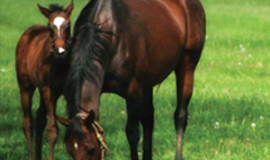Prepare for good grazing After a long winter horses will again be back on lush pastures. The transition from indoor feeding to grazing requires proper preparations, if you are to avoid digestive problems and maintain a good health. Needless to say, fences and gates must be in good technical condition. Take some time to tidy up the field. Remove accumulated trash (plastic, bottles, sharp items) that have “stranded” in the pasture during winter. Control the water supplies, and provide salt licks (sodium chloride). Horses should be wormed before they are…
Pegus News
Fructans in pasture grasses
Pasture grasses produce fructans as a storage carbohydrate. As the horse cannot digest the fructans enzymatically in the small intestine, they are digested by the microbes in the hind-gut, leading to production of volatile fatty acids and lactate. Increased lactate concentration lowers pH and alters the balance between the different strains of gut microbes. High intake of fructans can therefore lead to severe conditions as colic and laminitis in horses. What are fructans? Fructans consist of fructose units that are linked together. The chain length can vary from less than…
Analyzing sugar in hays and haylage
Among horse owners, there is a significant level of interest in the sugar content of hays and haylages. This is mainly because a high sugar content in forages can cause problems, especially for horses and ponies with diseases such as Cushings syndrome, insulin resistance and laminitis. Sugar analyses There are several different types of sugar analysis used by commercial labs. Their reports often make reference to what they term sugar. It is important however, that the methods they use should also be clearly indicated, to clarify which types of sugar…
Biotin… No Hoof No Horse!
Biotin is a B-vitamin and is often added to horse rations. For some horses it can improve the quality and growth of the hoof. Biotin plays an important role in intermediary metabolism. It is a co-enzyme and is involved in fatty acid synthesis, gluconeogenesis, amino acid metabolism, and metabolism of cholesterol and odd-chain fatty acids. Biotin is also essential for cell proliferation. Sources In the horse the gut microbes produce biotin and the concentration of biotin in the digesta increases in the hind-gut. Biotin is found in feeds commonly used…
Energy requirement for exercised horses
Energy requirement for exercised horses… When horses are being exercised, their energy requirement increases and the amount of energy (MJ) in the ration has to be increased accordingly. It is difficult to accurately estimate the extra energy needed as a result of exercise, and several models have been proposed. Here we will describe how Pegus Horse Feeds uses PC-Horse to calculates the energy requirement of exercised horses. What is exercise? Exercise can be defined as physical activity that increases oxygen consumption.This increase in oxygen consumption is dependent on the…
Changing the body condition of your horse
Changing the body condition of your horse If a horse is too fat or too thin its body condition should be corrected. If the horse is healthy, have proper dental care and is dewormed according to your veterinarian’s advice, the body condition will to a major extent be a result of the horse’s physical activity, production (pregnant, lactating, growing) and energy intake. Body condition scoring To describe the body condition of a horse, we use a system where a horse’s body condition score (BCS) can be set. The scale goes…
Group feeding of horses during winter
Group feeding of horses during winter Many horses are kept outdoors and fed as a group during winter. For this, we have to take into account extra challenges presented by cold weather conditions. Horses are very adaptable to cold weather, but factors such as age, body condition, breed, acclimatization and feeding will all influence the tolerance of cold in each individual’s case. A good management and feeding regime is therefore especially important during winter. What determines the cold tolerance? How well will horses tolerate cold weather conditions? This can be…
Carbohydrates in horse nutrition
Carbohydrates are the major source of energy for the horse. However, the carbohydrates are a big family including a great variety of components from the simple sugars to the more complex starches and celluloses. The different carbohydrates are digested either enzymatically in the small intestine or fermented by intestinal microbes mainly in the hind-gut. Small intestinal digestion In the small intestine, sugar and starch is enzymatically broken down to simple sugars and absorbed to the blood as glucose (blood sugar). Here it is transported to the liver, muscles and other…







